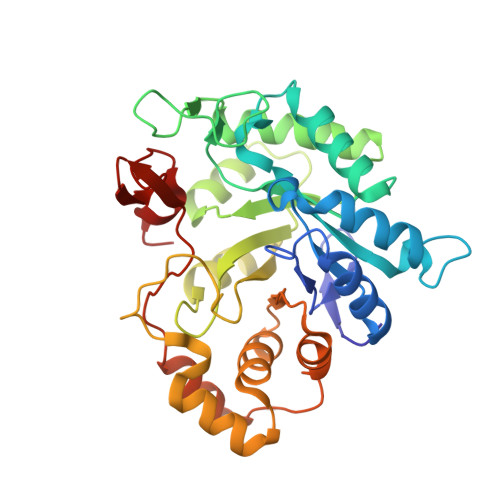Structure of aldehyde reductase in ternary complex with a 5-arylidene-2,4-thiazolidinedione aldose reductase inhibitor.
Carbone, V., Giglio, M., Chung, R., Huyton, T., Adams, J., Maccari, R., Ottana, R., Hara, A., El-Kabbani, O.(2010) Eur J Med Chem 45: 1140-1145
- PubMed: 20036445
- DOI: https://doi.org/10.1016/j.ejmech.2009.12.019
- Primary Citation of Related Structures:
3FX4 - PubMed Abstract:
The structure of aldehyde reductase (ALR1) in ternary complex with the coenzyme NADPH and [5-(3-carboxymethoxy-4-methoxybenzylidene)-2,4-dioxothiazolidin-3-yl]acetic acid (CMD), a potent inhibitor of aldose reductase (ALR2), was determined at 1.99A resolution. The partially disordered inhibitor formed a tight network of hydrogen bonds with the active site residues (Tyr50 and His113) and coenzyme. Molecular modelling calculations and inhibitory activity measurements of CMD and [5-(3-hydroxy-4-methoxybenzylidene)-2,4-dioxothiazolidin-3-yl]acetic acid (HMD) indicated that pi-stacking interactions with several conserved active site tryptophan residues and hydrogen-bonding interactions with the non-conserved C-terminal residue Leu300 in ALR2 (Pro301 in ALR1) contributed to inhibitor selectivity. In particular for the potent inhibitor CMD, the rotameric state of the conserved residue Trp219 (Trp220 in ALR1) is important in forming a pi-stacking interaction with the inhibitor in ALR2 and contributes to the difference in the binding of the inhibitor to the enzymes.
Organizational Affiliation:
Medicinal Chemistry and Drug Action, Monash Institute of Pharmaceutical Sciences, Monash University, 381 Royal Parade, Parkville, Victoria 3052, Australia.

















